
An altar is a structure with an upper surface for the presentation of religious offerings, for sacrifices, or for other ritualistic purposes. Altars are found at shrines, temples, churches, and other places of worship. They are used particularly in Paganism, Christianity, Buddhism, Hinduism, Judaism, and Modern Paganism. Many historical faiths also made use of them, including the Roman, Greek, and Norse religions.
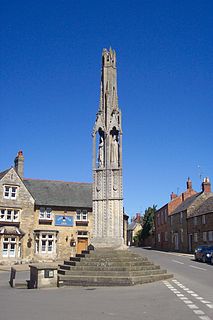
The Eleanor crosses were a series of twelve tall and lavishly decorated stone monuments topped with crosses erected in a line down part of the east of England. King Edward I had them built between 1291 and about 1295 in memory of his beloved wife Eleanor of Castile. The King and Queen had been married for 36 years and she stayed by the King’s side through his many travels. While on a royal progress, she died in the East Midlands in November 1290. The crosses, erected in her memory, marked the nightly resting-places along the route taken when her body was transported to Westminster Abbey near London.

A high cross or standing cross is a free-standing Christian cross made of stone and often richly decorated. There was a unique Early Medieval tradition in Ireland and Britain of raising large sculpted stone crosses, usually outdoors. These probably developed from earlier traditions using wood, perhaps with metalwork attachments, and earlier pagan Celtic memorial stones; the Pictish stones of Scotland may also have influenced the form. The earliest surviving examples seem to come from the territory of the Anglo-Saxon kingdom of Northumbria, which had been converted to Christianity by Irish missionaries; it remains unclear whether the form first developed in Ireland or Britain.
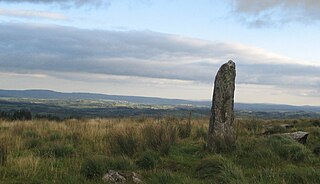
A menhir, standing stone, orthostat, or lith is a large man-made upright stone, typically dating from the European middle Bronze Age. They can be found individually as monoliths, or as part of a group of similar stones. Menhirs' size can vary considerably, but they often taper toward the top.

The Celtic cross is a form of Christian cross featuring a nimbus or ring that emerged in Ireland, France and Great Britain in the Early Middle Ages. A type of ringed cross, it became widespread through its use in the stone high crosses erected across the islands, especially in regions evangelized by Irish missionaries, from the ninth through the 12th centuries.

A megalith is a large stone that has been used to construct a prehistoric structure or monument, either alone or together with other stones. There are over 35,000 in Europe alone, located widely from Sweden to the Mediterranean sea.
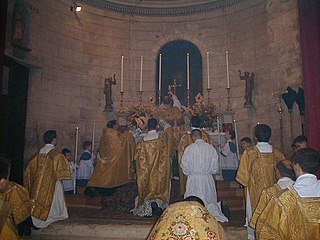
Vestments are liturgical garments and articles associated primarily with the Christian religion, especially by Eastern Churches, Catholics, Anglicans, and Lutherans. Many other groups also make use of liturgical garments; this was a point of controversy in the Protestant Reformation and sometimes since, in particular during the ritualist controversies in England in the 19th century.
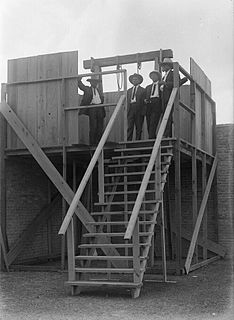
A gallows is a frame or elevated beam, typically wooden, from which objects can be suspended or "weighed". Gallows were thus widely used to suspend public weighing scales for large and heavy objects such as sacks of grain or minerals, usually positioned in markets or toll gates. The term was also used for a projecting framework from which a ship's anchor might be raised so that it is no longer sitting on the bottom, i.e., "weighing [the] anchor,” while avoiding striking the ship’s hull.

A stele, or occasionally stela, when derived from Latin, is a stone or wooden slab, generally taller than it is wide, erected in the ancient world as a monument. The surface of the stele often has text, ornamentation, or both. These may be inscribed, carved in relief, or painted.

A khachkar, also known as an Armenian cross-stone is a carved, memorial stele bearing a cross, and often with additional motifs such as rosettes, interlaces, and botanical motifs. Khachkars are characteristic of Medieval Christian Armenian art.

A stone row or stone alignment is a linear arrangement of upright, parallel megalithic standing stones set at intervals along a common axis or series of axes, usually dating from the later Neolithic or Bronze Age. Rows may be individual or grouped, and three or more stones aligned can constitute a stone row.
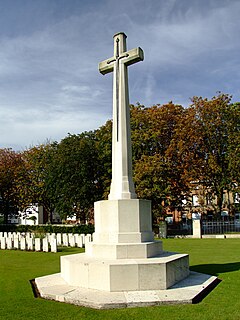
The Cross of Sacrifice is a Commonwealth war memorial designed in 1918 by Sir Reginald Blomfield for the Imperial War Graves Commission. It is present in Commonwealth war cemeteries containing 40 or more graves. Its shape is an elongated Latin cross with proportions more typical of the Celtic cross, with the shaft and crossarm octagonal in section. It ranges in height from 18 to 24 feet. A bronze longsword, blade down, is affixed to the front of the cross. It is usually mounted on an octagonal base. It may be freestanding or incorporated into other cemetery features. The Cross of Sacrifice is widely praised, widely imitated, and the archetypal British war memorial. It is the most imitated of Commonwealth war memorials, and duplicates and imitations have been used around the world.

King Doniert's Stone consists of two pieces of a decorated 9th-century cross, near St Cleer on Bodmin Moor, Cornwall. The inscription is believed to commemorate Dungarth, King of Cornwall, who died around 875.
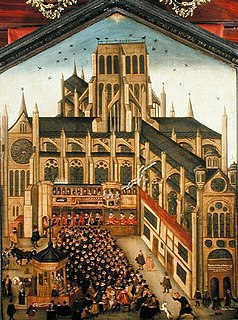
St Paul's Cross was a preaching cross and open-air pulpit in the grounds of Old St Paul's Cathedral, City of London. It was the most important public pulpit in Tudor and early Stuart England, and many of the most important statements on the political and religious changes brought by the Reformation were made public from here. The pulpit stood in 'the Cross yard', the open space on the north-east side of St. Paul's Churchyard, adjacent to the row of buildings that would become the home of London's publishing and book-selling trade.

A wayside shrine is a religious image, usually in some sort of small shelter, placed by a road or pathway, sometimes in a settlement or at a crossroads, but often in the middle of an empty stretch of country road, or at the top of a hill or mountain. They have been a feature of many cultures, including Chinese folk religious communities, Catholic and Orthodox Europe and Shinto Japan.

A summit cross is a cross on the summit of a mountain or hill that marks the top. Often there will be a summit register (Gipfelbuch) at the cross, either in a container or at least a weatherproof case.

Abraham Lincoln is a marble sculpture of U.S. President Abraham Lincoln by Irish artist Lot Flannery, located in front of the old District of Columbia City Hall in Washington, D.C., United States. The statue is the nation's oldest extant memorial to the president and was installed several blocks from Ford's Theatre, where Lincoln was assassinated. Flannery was present at the theater on the night of Lincoln's assassination.

Dysart and Ruan is a Catholic parish in County Clare, Ireland. It covers the civil parishes of Ruan and Dysert, and includes the village of Ruan, which holds the parish office. The parish contains the ruins of the 12th century St. Tola's Church, part of Dysert O'Dea Monastery.

The ringed cross is a class of Christian cross symbols featuring a ring or nimbus. The concept exists in many variants and dates to early in the history of Christianity. One variant, the cruciform halo, is a special type of halo placed behind the head of Jesus in Christian art. Other common variants include the Celtic cross, used in the stone high crosses of Ireland and Britain; some forms of the Coptic cross; and ringed crosses from western France and Galicia.



















